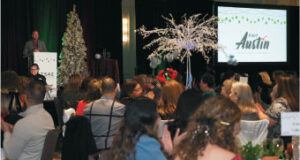How Your Association Can Attract Future Talent


By Jill Silman Chapman, SPHR, SHRM-SCP, MS-HRM
The uncertainty of what work life will look like in the future raises lots of questions and anxiety for employers today.
Will we still have blue-collar and white-collar jobs, or will we move toward a no-collar workplace? Will automation create a more mechanical workforce augmented by human creativity and contribution that results in a culture of human and machine collaboration? Will virtual employees become the norm?
We’re caught today in a dizzying whirl of change in the work world due to digitization, the rise of automation and shifting demographics.
No one knows for sure what will motivate workers 10, 20 or 30 years down the road, but knowing where we are today and planning for what we think will happen tomorrow will help us face the future more confidently.
Where We are Today
There’s more talk than ever before about the millennial generation, because millennials are rapidly becoming the largest concentration of workers. That means the balance of power in the workplace is shifting. Despite this shift, drivers for talent acquisition and management remain the same among all generations and include the desire to contribute to society, make a difference and feel valued.
Along with these drivers, all workers expect trustworthy leaders to provide regular feedback and place an emphasis on lifelong learning.
Where We’re Going
Look toward the future with your workforce. Attracting, motivating and retaining top talent requires recognizing your employees’ needs and responding to them to remain competitive and relevant in your industry. Consider these seven trending areas where you can have an impact today that will also position you well for the future, whatever it brings for your organization.
1. A non-hierarchical workplace.
A shift in traditional career pathing of advancement recognizes careers of achievement, where people are happy in the job they’re doing and don’t want to be promoted into a job they don’t really want or may not be suited for. Today’s employees believe they should be able to earn more compensation, credibility or power for continued contributions to the role they’re in.
2. Transparent organizations that foster trust.
A significant trend in business is toward transparency. A younger workforce that grew up sharing their lives on social media is demanding that employers are open and honest about association information. As a result, more and more companies are sharing financial information with employees. The more transparent your association is, the more your employees trust you.
One of the most significant contributors to an organization’s success is trust. Employees who perceive their companies as fair, dependable and competent have a higher level of trust and are more willing to work hard for that association.
3. Highly collaborative, remote and flexible workplaces.
Collaboration in the workplace has always been important, but it has become increasingly so as more businesses offer telecommuting and remote work options for employees. The benefits of collaboration between teams and employees, whether remote or in office, include better organization and delegation of tasks, improved progress tracking and increased productivity.
Consider what positions you have that can be handled remotely or with a flexible schedule.
4. A culture of ongoing feedback.
The need for continual feedback tends to be associated with millennials, but it’s important to every generation. Employees who don’t receive the feedback they want will likely look for work elsewhere. Effective feedback doesn’t have to be a formal process. Supplement formal meetings with informal conversations, emails, texts and IMs, and include peer-to-peer conversations.
5. Physical amenities to fit all needs.
Your association will be viewed as innovative and will likely have higher performing employees when you offer them options for how and where they can work. This doesn’t mean wiping offices out and starting from scratch, however. Determine the environment that works best for your workforce. Community tables and open spaces foster creative environments, but employees who need to focus for best productivity need their own desks and private meeting spaces.
6. Personal, as well as professional, development.
Employees respond to a positive coach who can make a difference in their success. Millennials, in particular, view their managers as their number one source of personal development – and they want that more than managerial direction. They want managers who will inspire them, surround them with great people and be authentic in their interactions. Sharing struggles as well as successes goes a long way to being approachable and becoming a role model for employees to emulate.
7. A strong sense of belonging.
Diversity and inclusion: it can’t be overstated. If an employee doesn’t feel like they’re part of the team, they’ll be looking to leave your association. As an employer, you need to embrace and celebrate a diverse workforce that brings different skills and perspectives to finding solutions. Build relationships across differences, and enforce anti-discrimination and harassment policies.
A key challenge today for most workplaces is being able to scale rapidly while keeping an innovative edge. The main obstacles to rapid responsiveness across organizations in an array of industries are slow decision-making, conflicting departmental goals and priorities, risk-averse cultures and silo-based information that makes collaboration difficult.
Innovation will help ensure your association’s agility, but in order to innovate, you must:
1. Take risks.
Create a culture where risk-taking is encouraged by giving employees space and autonomy to develop and contribute ideas. Giving employees goals to work toward on their own allows you to check in and offer guidance without micro-managing.
2. Be agile.
Take risks, and then learn from the experience. An agile workforce is made up of employees who can be reskilled quickly to meet new association goals and strategies based on industry trends. Cross-functional teams of employees with differing skill sets allow the team to benefit from cross-departmental knowledge, as well as come up with insightful and out-of-the-box ideas.
How does your organization need to change today to evolve and stay competitive for the future?
It’s clear that no one has a crystal ball to show us what the workplace of the future looks like, but these practices can be pillars for your association’s business success today and into the future.
Jill Silman Chapman, SPHR, SHRM-SCP, MS-HRM, is a senior performance consultant with Insperity, which provides human resources and business solutions to companies across America.
Photo credit: iStock.com/alphaspirit




